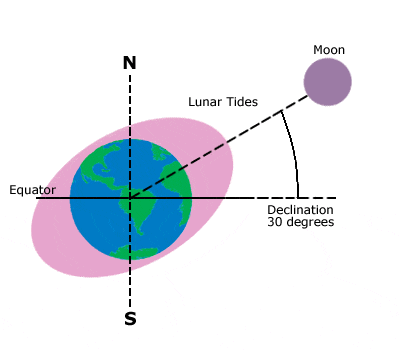Tides and Water Levels
Changing Angles and Changing Tides
As we’ve just seen, the Earth's two tidal bulges are aligned with the positions of the moon and the sun. Over time, the positions of these celestial bodies change relative to the Earth’s equator. The changes in their relative positions have a direct effect on daily tidal heights and tidal current intensity.
As the moon revolves around the Earth, its angle increases and decreases in relation to the equator. This is known as its declination. The two tidal bulges track the changes in lunar declination, also increasing or decreasing their angles to the equator. Similarly, the sun’s relative position to the equator changes over the course of a year as the Earth rotates around it. The sun’s declination affects the seasons as well as the tides. During the vernal and autumnal equinoxes—March 21 and September 23, respectively—the sun is at its minimum declination because it is positioned directly above the equator. On June 21 and December 22—the summer and winter solstices, respectively—the sun is at its maximum declination, i.e., its largest angle to the equator (Sumich, J.L., 1996).

The Earth’s tidal bulges track, or follow, the position of the moon, and to a lesser extent, the sun. As the angles of these two celestial bodies in relation to the Earth increase and decrease, so do the tidal bulges. Here we observe the moon's changing declination to the equator and the effect that this has on the positions of the Earth’s tidal bulges.
Tides and Water Levels
